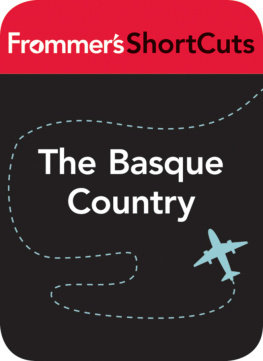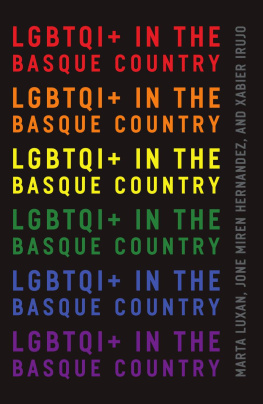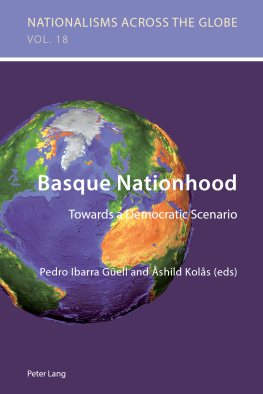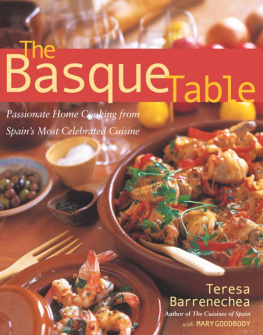
Basque Country
A Culinary Journey Through a Food Lover's Paradise
Marti Buckley
Photographs by Simon Bajada

Artisan New York

For the Basques and for Buckley

Contents

FOREWORD
Firewood in the oven, the crackle of a fire, the profound aroma of earth, and a countryside teeming with lifethese are the flavors of the morning at Etxebarri, my restaurant in the tiny village of Axpe, Bizkaia. These smells, sounds, and sights are typical of a Basque village. Youll find them not only in my kitchen but also in the kitchens of so many Basques who have come before me.
Marti Buckley is a seeker of essences, a determined researcher, and an enthusiastic investigator. With an outsiders point of view, she has delved into a singular culture and tradition. Using her experiences in the kitchens of Basque Country, she has completed an entertaining, straightforward book that allows us to catch a glimpse and exalt the roots of Basque cuisine. Buckley captures a way of cooking that has always had respect for raw materials and humility, forging its own place on the worlds culinary stage, away from the mainstream.
A unique, captivating atmosphere, natural yet powerfulthis is the magic of Basque Country. The link between our food and nature remains unbroken. The result is rustic yet elegant, simple yet refined. Basque Country is rooted in tradition, and its cuisine is no different.
I hope you enjoy this book, and that you live it through your senses, which offer us new ways of perceiving things. This collection of recipes contains our most traditional dishes, those that evoke sensory memories for any Basque, whisking us straight to our grandmothers table and the dining societies, restaurants, bars, and grill houses of Basque Country.
Bittor Arginzoniz, chef and owner, Etxebarri

Introduction: The Basque Country
Basques are uniquely obsessed with food. This is no surprise in a land so abundant in edible natural resources. Sparkling rivers, cold seas, humid forests, and lush valleys all contribute excellent-quality ingredients, arguably some of the best in the world. And the home and professional cooks inhabiting this food-loving culture know what to do with themfrom brilliantly simple sauced fish to homey stews rich with peppers and onions, the Basque cuisine excels at taking a good product and enhancing, not hiding, its flavor.
Everything of importance in this small region, nestled in the north corner of Spain and the south of France, happens around the table. This table takes different forms, all of them wonderfully iconica bartop scattered with pintxos (small bites); a slab of wood with a shiny patina from years of Sunday farmhouse lunches; or a white tablecloth in a Michelin-starred restaurant. But the uniqueness of the Basque cuisine lies in its other restaurants: homes, dining societies, cider houses, cooking competitions, and fairs that have kept a food tradition vibrant and lively, preserving dishes over hundreds of years and creating an insular recipe collection that is remade (and, consequently, improved) over and over and over.
Renowned worldwide, Basque cuisine is first and foremost about the ingredients, the freshest of raw products: just-caught seafood; excellent meat and game; produce; oils; sheeps-milk cheese; hard cider; and wine. The Basque people have cultivated a sense of taste that can distinguish between a local fish and one caught in faraway waters, further heightened by an insistence on simplistic, natural cooking. Basque cooking requires patience, employing techniques like slow poaching and simmering, rather than an excess of ingredients, to achieve depth of flavor.
The cult of good eating, as some call it, in Basque Country has been shaped and formed by a hungry public. The champions of Basque cuisine are manyfrom the erudite Jos Maria Busca Isusi of Zumarraga (a food scholar taught and influenced by the females in his family who is considered one of the eminences of Basque cuisine) to the founders of the nueva cocina movement to the bloggers and about-towners who keep the traditions alive in the twenty-first century. Each is a product of their time, witness to the changing landscape of Basque culture and Basque cuisine. A cuisine first led by the hand of nature and fortune, across the wild seas and into the coldest rocky valleys, was tamed by the etxekoandre , the female head of the household. There is a high level of culinary literacy among the Basques; much like the language, the cuisine was transmitted orally in home kitchens. Even young people can fend for themselves in the kitchen and enjoy food-related banter. Taught by their mothers or grandmothers, these young people go on to be sukaldariak , chefs, whose curiosity continues to push the cuisine to new frontiers.

The demands of the Basque diner, however, are what really keep this tradition alive. Conceiving of a relationship or a celebration without food is truly impossible for a Basque, which makes for a lot of socially coded eating times. Morning coffee is followed by the hamaiketako , a light snack, usually something salty, taken around eleven a.m. or noon and often accompanied with a drink. Lunch is the largest, most important meal of the day, eaten in the neighborhood of two p.m. on the Spanish side and twelve thirty or one p.m. on the French side. On weekends, most people have a drink in a local caf or bar or on any number of terraces before a family lunch, and on weekdays, its common to grab a drink and a snack with friends after work and before (or for) dinner. The phenomenon of going out for a premeal drink and snack was what gave birth to the regions famous pintxo culture. The Basque often finishes the day with a smaller meal, perhaps calling it a night after a few pintxos.
Not all the dining is done at home or in bars, however. The txoko , or dining society, is a pillar of Basque cuisine even more foundational than restaurants. Behind the doors of these private clubs, techniques are practiced and perfected by the average cook, and the excitement of friendly competition and a sense of occasion keep the Basque culinary tradition alive.
My first experience in Basque Country was as a hungry university student on an exchange program in Irua (known as Pamplona in Spanish), the capital of Nafarroa. During the semester-long experience, I barely cracked the surface, but I could sense that there was something special about this place, the people, and the land. It left me with a gnawing hunger in my belly for all things Basque. Back in the States, I attempted to satiate it by drinking Rioja, watching Spanish movies, and listening to Basque-mix CDs from friends, but deep down, I always knew I would go back.
Next page














